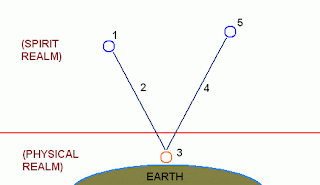Mapping the Greatest Missionary's Journey
Jesus is the greatest missionary, as seen in the tremendous personal sacrifices he endured to bring sinners into salvation. (Acts 4:12; 1 John 5:11-13) Below is a simplified map of this historic journey.[1]
[1] Compare with Jacob's ladder vision in Genesis 28:12, which depicts angels ascending and descending on a ladder or staircase from heaven to earth.
Further reading:
Related blog entries:
- Jesus' pre-human position in heavenly/spiritual/divine glory. (John 17:5)
- The (a) kenosis and (b) katabasis, the (a) emptying or divesting of his divine glory and (b) him 'stepping down' into the physical realm on earth. (Philippians 2:7; Hebrews 2:17; Ephesians 4:9)
- Conveyed by holy spirit to Mary's womb and born as a perfect man. (Matthew 1:18; Luke 1:35; Galatians 4:4) His life and death. (Philippians 2:7, 8; Hebrews 2:17)
- His resurrection back to spirit life, his anabasis: 'stepping up' into the spirit realm. (Galatians 1:1; 1 Corinthians 15:45; 1 Peter 3:18)
- Jesus' current exalted position as immortal in heavenly/spiritual/divine glory. (Philippians 2:9-11; Colossians 2:9; 1 Timothy 6:16; Revelation 3:21)
 |
| See John 8:23, where Jesus said he is from "the realms above" (the transcendent spirit realm), and we reside in "the realms below," on the earth in the physical realm (NW). |
[1] Compare with Jacob's ladder vision in Genesis 28:12, which depicts angels ascending and descending on a ladder or staircase from heaven to earth.
Further reading:
- Who Is Jesus Christ? www.jw.org/en/publications/books/bible-teach/who-is-jesus-christ/
- The Ransom—God’s Greatest Gift www.jw.org/en/publications/books/bible-teach/the-ransom-gods-greatest-gift/
Related blog entries:
- A simplified diagram of reality http://jimspace3000.blogspot.com/2011/01/simplified-diagram-of-reality.html
- Messianic Symbolism of Jonah http://jimspace3000.blogspot.com/2011/05/messianic-symbolism-jonah-jonah-wayward.html
- Jesus: a Spirit Born on Earth http://jimspace3000.blogspot.com/2011/02/jesus-spirit-born-on-earth-jesus-was.html
- The Exaltation of Christ http://jimspace3000.blogspot.com/2011/08/exaltation-of-christ-god-elevated-him.html
- Great Illustration of Transcendence http://jimspace3000.blogspot.com/2012/05/great-illustration-of-transcendence-if.html
- Passing Through the Curtain http://jimspace3000.blogspot.com/2014/12/passing-through-curtain.html
- A case for Christ's pre-human existence http://jimspace3000.blogspot.com/2011/07/case-for-christs-pre-human-existence.html
- Jesus’ life before his birth http://jimspace3000.blogspot.com/2014/06/comparing-saving-schemes-what-must-i-do.html
Labels: Bible, Christological preexistence


